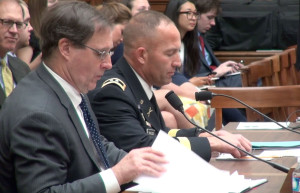 David Sedney, deputy assistant secretary of defense for Afghanistan, Pakistan and Central Asia testifies before the House Armed Services Committee. (Meghan Anne Bunchman)
David Sedney, deputy assistant secretary of defense for Afghanistan, Pakistan and Central Asia testifies before the House Armed Services Committee. (Meghan Anne Bunchman)
WASHINGTON — A top Pentagon official said progress has been made in improving the lives of women in Afghanistan, but experts and some members of Congress disputed that assessment at a House Armed Services Committee hearing Thursday.
With the military set to withdraw 34,000 troops from Afghanistan early next year, the safety and security of Afghan women is the top concern of some elected officials and observers.
Many Afghan women say they want to leave the country before 2014, said Stephanie Sanok, deputy director of the International Security Program at the Center for Strategic and International Studies, who has taken several trips to Afghanistan.
“I am deeply troubled by what may lie ahead,” Rep. Martha Roby, R-Ala., said during the hearing. She said she worries about what will happen once the military moves to a support role in Afghanistan, with Afghan forces in the lead, perhaps leaving room for Taliban resurgence.
“I am a wife and mother who has had the right and privilege to pursue an education, career and elected office,” Roby said. “I do not want Afghan women to face a future where their successes and security is jeopardized. I fear this would be the case if Afghanistan reverts to the Taliban’s control, or a more strict and oppressive government otherwise takes root there.”
But David Sedney, deputy assistant secretary of defense for Afghanistan, Pakistan and Central Asia, stressed the overall improvements that Afghanistan has made since 2001, including the progress of women in the fields of health, education and the political arena.
Women now hold 27 percent of the seats in the Afghanistan National Assembly, and two women serve on the High Peace Council’s 19-member executive board, according to Sedney’s written testimony.
Marine Gen. Joseph Dunford, commander of U.S. forces in Afghanistan, also noted progress for women in Afghanistan during a Senate Armed Services Committee hearing April 16.
“The progress we have made to date provides real opportunity,” Dunford said, pointing to the growing numbers of women enrolled in schools and holding jobs as teachers. In 2001, there were 20,000 teachers, all men. Now, there are 200,000 teachers and 40 percent of them are women.
But, “despite advances, the troubles of poverty, illiteracy, weak security and poor health care” continue to disproportionately affect Afghan women, Sedney said.
According to the United Nations, more than 300 women and girls have been killed, and more than 560 were injured in 2012 — representing a 20 percent increase in casualties over the previous year.
Last month, United Nations Secretary General Ban Ki-moon expressed strong concern about these incidents, saying he remains “deeply disturbed that despite some improvements in prosecuting cases of violence, there is still a pervasive climate of impunity in Afghanistan for abuses of women and girls.”
To counter this, the Defense Department says it will focus its efforts to support women’s security in Afghanistan through the Afghan National Security Forces “development mission” by increasing the numbers of Afghan women recruited into the Afghan military and raising their status within the military.
“Ensuring that this increase of civil and political participation continues and improves is dependent upon an effective rule of law,” Sedney said. “And effective rule of law is dependent on the presence of women in the justice system.”
